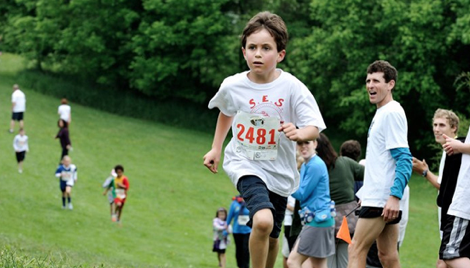Posted on 28 September 2011
 As a family physician, I firmly believe that children should play in their bare feet or in activity shoes that complement natural foot development and proper biomechanics of movement. Runners, walkers, coaches, and the medical community are all awakening to the benefits of allowing proper natural foot motion to occur in all of our daily activities. Leaders in the running mechanics, sports medicine, dancing, and yoga/tai chi communities all understand that the smartest design that will ever be developed for human movement and injury free activity is the human foot itself. Running shoe companies are adapting their product lines to create footwear that allows your foot to behave like a foot, but most have only applied this new thinking to adult models.
As a family physician, I firmly believe that children should play in their bare feet or in activity shoes that complement natural foot development and proper biomechanics of movement. Runners, walkers, coaches, and the medical community are all awakening to the benefits of allowing proper natural foot motion to occur in all of our daily activities. Leaders in the running mechanics, sports medicine, dancing, and yoga/tai chi communities all understand that the smartest design that will ever be developed for human movement and injury free activity is the human foot itself. Running shoe companies are adapting their product lines to create footwear that allows your foot to behave like a foot, but most have only applied this new thinking to adult models.
...Here’s an important point to keep in mind – a child’s foot is not a miniature version of an adult’s foot. In early development, a child’s foot is widest across the toes. If our population wore shoes that were designed with this functional shape from birth, most adults would also have feet with the widest part across the toes, and the toes would be perfectly aligned with the metatarsals (long bones in midfoot). Most of a child’s developing foot is composed of cartilage, which is gradually replaced by bone. If the cartilage is deformed by badly shaped or rigid shoes, the bones will take on the deformed shape. More than 80 percent of foot problems, bunions and injuries are a result of misshaped and inflexible shoes. It’s vital that kids’ shoes allow enough room for natural growth, until the foot bones mature. This doesn’t happen until ages 18-19 for girls and 20-21 for boys. Simply put; inflexible, poorly shaped shoes are potentially harmful – they restrict the natural movement and development of the foot.
So what are the important features to look for in a child’s shoe?
ReplyDelete*Ultra-thin soles to allow proper proprioception, neuromuscular activation in the entire kinetic chain, and to complement the body’s natural ability to absorb ground forces.
*Low, flat to the ground profile – shoes should allow all play activity that involves climbing, running, and jumping. Shoes should enhance lateral movement since the foot will not be up on a platform or have a slope from heel to forefoot.
*The materials should be soft and supple, thereby allowing natural foot function. The shoe should bend easily at the toe joints – this is where a foot is designed to bend to recreate the arch on takeoff.
*The toebox should be wide enough to allow natural toe spread. Foot support is created by the natural arch of the foot with the great toe stabilizing the arch. When the heel is elevated and great toe deviated toward the second toe (a common design flaw in many shoes which come to a point), this stability is compromised. The foot produces the most leverage when the toes are straight and aligned with the metatarsals. A child’s foot is widest at the ends of the toes (as should an adult’s be if they have been in proper shoes or barefoot).
*A single piece midsole/outsole allowing protection on unnatural surfaces (concrete, asphalt) and natural rough surfaces (rock,trail) while allowing proprioception and natural dissipation of ground reaction forces.
*Upper material should be soft, breathable, and washable.
*Get over the notion that shoes need “traction.” In a moving child the more stickiness and grip, the more heat produced in the foot and braking moments on running activity.
*Discourage the use of thick, heavy socks as these interfere with foot proprioception.